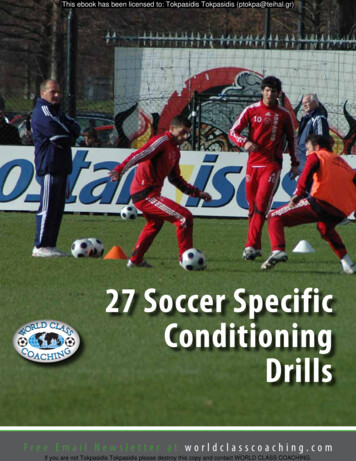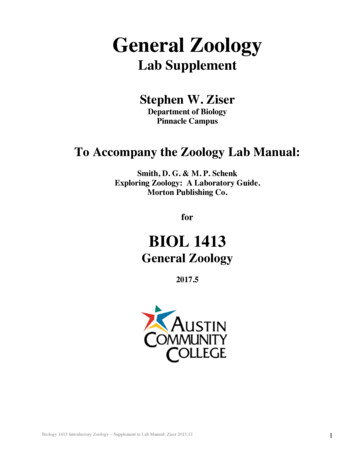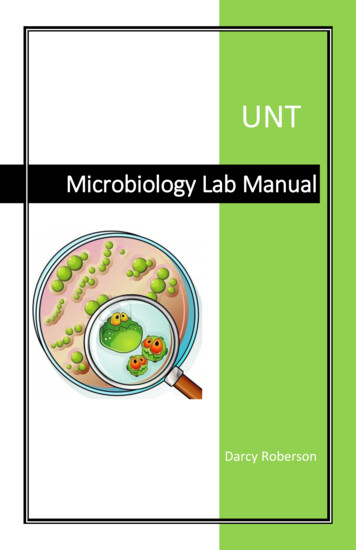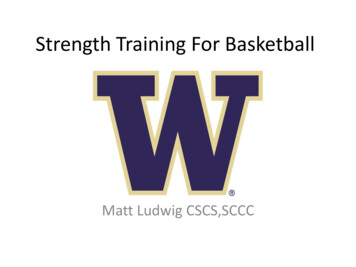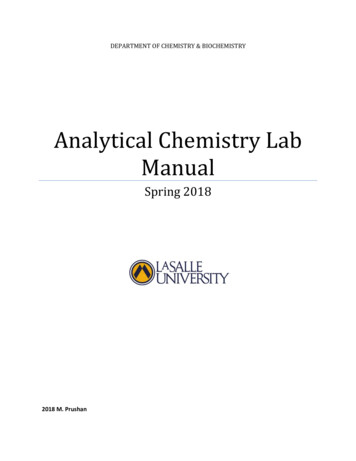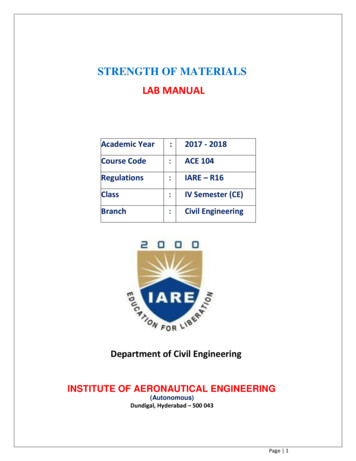
Transcription
STRENGTH OF MATERIALSLAB MANUALAcademic Year:2017 - 2018Course Code:ACE 104Regulations:IARE – R16Class:IV Semester (CE)Branch:Civil EngineeringDepartment of Civil EngineeringINSTITUTE OF AERONAUTICAL ENGINEERING(Autonomous)Dundigal, Hyderabad – 500 043Page 1
INSTITUTE OF AERONAUTICAL ENGINEERING(Autonomous)Dundigal, Hyderabad - 500 043DEPARTMENT OF CIVIL ENGINEERINGProgram: Bachelor of Technology (B. Tech)VISION OF THE DEPARTMENTTo produce eminent, competitive and dedicated civil engineers by imparting latesttechnical skills and ethical values to empower the students to play a key role in theplanning and execution of infrastructural & developmental activities of the nation.MISSION OF THE DEPARTMENTTo provide exceptional education in civil engineering through quality teaching, state-ofthe-art facilities and dynamic guidance to produce civil engineering graduates, who areprofessionally excellent to face complex technical challenges with creativity, leadership,ethics and social consciousness.Page 2
INSTITUTE OF AERONAUTICAL ENGINEERING(Autonomous)Dundigal, Hyderabad - 500 043DEPARTMENT OF CIVIL ENGINEERINGProgram: Bachelor of Technology (B. Tech)PROGRAM OUTCOMES (PO’s)Engineering knowledge: Apply the knowledge of mathematics, science,PO 1engineering fundamentals, and an engineering specialization to thesolution of complex engineering problems.Problem analysis: Identify, formulate, review research literature, andPO 2analyze complex engineering problems reaching substantiatedconclusions using first principles of mathematics, natural sciences, andengineering sciences.Design/development of solutions: Design solutions for complexengineering problems and design system components or processes thatPO 3meet the specified needs with appropriate consideration for the publichealth and safety, and the cultural, societal, and environmentalconsiderations.Conduct investigations of complex problems: Use research-basedPO 4knowledge and research methods including design of experiments,analysis and interpretation of data, and synthesis of the information toprovide valid conclusions.Modern tool usage: Create, select, and apply appropriate techniques,PO 5resources, and modern engineering and IT tools including prediction andmodeling to complex engineering activities with an understanding of thelimitations.Page 3
The engineer and society: Apply reasoning informed by the contextualPO 6knowledge to assess societal, health, safety, legal and cultural issues andthe consequent responsibilities relevant to the professional engineeringpractice.Environment and sustainability: Understand the impact of thePO 7professional engineering solutions in societal and environmentalcontexts, and demonstrate the knowledge of, and need for sustainabledevelopment.Ethics: Apply ethical principles and commit to professional ethics andPO 8responsibilities and norms of the engineering practice.Individual and team work: Function effectively as an individual, and asPO 9a member or leader in diverse teams, and in multidisciplinary settings.Communication: Communicate effectively on complex engineeringactivities with the engineering community and with society at large, suchPO 10as, being able to comprehend and write effective reports and designdocumentation, make effective presentations, and give and receive clearinstructions.Project management and finance: Demonstrate knowledge andPO 11understanding of the engineering and management principles and applythese to one‟s own work, as a member and leader in a team, to manageprojects and in multidisciplinary environments.Life-long learning: Recognize the need for, and have the preparation andPO 12ability to engage in independent and life-long learning in the broadestcontext of technological change.Page 4
INSTITUTE OF AERONAUTICAL ENGINEERING(Autonomous)Dundigal, Hyderabad - 500 043DEPARTMENT OF CIVIL ENGINEERINGProgram: Bachelor of Technology (B. Tech)The Program Specific outcomes (PSO‟s) listed below were developed specifically to meetthe Program Educational Objectives (PEO‟s). The focus of these PSO‟s is consistent withthe set of required PO‟s identified in the NBA accreditation guidelines.The Civil Engineering PSO‟s require that graduates receiving a Bachelor of Technologyin Civil Engineering degree from IARE demonstrate the following.PROGRAM SPECIFIC OUTCOMES (PSO’s)ENGINEERING KNOWLEDGE: Graduates shall demonstrate soundPSO 1knowledge in analysis, design, laboratory investigations and constructionaspects of civil engineering infrastructure, along with good foundation inmathematics, basic sciences and technical communicationBROADNESS AND DIVERSITY: Graduates will have a broadPSO 2understanding of economical, environmental, societal, health and safetyfactors involved in infrastructural development, and shall demonstrateability to function within multidisciplinary teams with competence inmodern tool usage.SELF-LEARNING AND SERVICE: Graduates will be motivated forPSO 3continuous self-learning in engineering practice and/or pursue research inadvanced areas of civil engineering in order to offer engineering services tothe society, ethically and responsibly.Page 5
STRENGTH OF MATERIALS LABORATORY – SYLLABUSExp. No.Name of the Experiment1Tension test2Deflection test on Cantilever beam3Deflection test on simply supported beam4Torsion test5Hardness test6Spring test7Compression test on wood or concrete,8Impact test10Shear test11Verification of Maxwell‟s reciprocal theorem on beams12Use of electrical resistance strain gauge13Deflection test on Continuous beamPage 6
ATTAINMENT OF PROGRAM OUTCOMES (PO’s) & PROGRAMSPECIFIC OUTCOMES (PSO’s)Exp.No.Name of ExperimentTension test1.Program OutcomesAttainedPO1(H), PO2(S), PO4(S),PO6(S), PO10(S)Program SpecificOutcomes AttainedPSO1(H), PSO2(S)2.Deflection test onCantilever beamPO1(H), PO2(S),PO4(S),PO6(S), PO10(S)PSO1(H), PSO2(S)3.Deflection test on simplysupported beamPO1(H), PO2(S),PO4(S),PO6(S), PO10(S)PSO1(H), PSO2(S)Torsion testPO1(H), PO2(S),PO4(S),PO6(S), PO10(S)PSO1(H), PSO2(S)Hardness testPO1(H), PO2(S),PO4(S),PO6(S), PO10(S)PSO1(H), PSO2(S)Spring testPO1(H), PO2(S),PO4(S),PO6(S), PO10(S)PSO1(H), PSO2(S)Compression test on woodor concrete,PO1(H), PO2(S), PO4(S),PO6(S), PO10(S)PSO1(H), PSO2(S)Impact testPO1(H), PO2(S), PO4(S),PO6(S), PO10(S)PSO1(H), PSO2(S)Shear testPO1(H), PO2(S), PO4(S),PO6(S), PO10(S)PSO1(H), PSO2(S)4.5.6.7.8.9.Verification of Maxwell‟sreciprocal theorem onbeamsPO1(H), PO2(S), PO4(S),PO6(S), PO10(S)PO1(H), PO2(S), PO4(S),PO6(S), PO10(S)PSO1(H), PSO2(S)11.Use of electrical resistancestrain gaugePO1(H), PO2(S), PO4(S),PO6(S), PO10(S)PSO1(H), PSO2(S)12.Deflection test onContinious beam10.PSO1(H), PSO2(S)Page 7
MANDATORY INSTRUCTIONS1.Students should report to the labs concerned as per the timetable.2.Record should be updated from time to time and the previous experiment mustbe signed by the faculty in charge concerned before attending the lab.3.Students who turn up late to the labs will in no case be permitted to perform theexperiment scheduled for the day.4.After completion of the experiment, certification of the staff in-chargeconcerned in the observation book is necessary.5.Students should bring a notebook of about 100 pages and should enter thereadings/observations/results into the notebook while performing theexperiment.6.The record of observations along with the detailed experimental procedure ofthe experiment performed in the immediate previous session should besubmitted and certified by the staff member in-charge.7.Not more than FIVE students in a group are permitted to perform theexperiment on a set up.8.The group-wise division made in the beginning should be adhered to, and nomix up of student among different groups will be permitted later.9.The components required pertaining to the experiment should be collected fromLab- in-charge after duly filling in the requisition form.Page 8
10. When the experiment is completed, students should disconnect the setup madeby them, and should return all the components/instruments taken for thepurpose.11. Any damage of the equipment or burnout of components will be viewedseriously either by putting penalty or by dismissing the total group of studentsfrom the lab for the semester/year.12.Students should be present in the labs for the total scheduled duration.13.Students are expected to prepare thoroughly to perform the experiment beforecoming to Laboratory.14.Procedure sheets/data sheets provided to the students groups should bemaintained neatly and are to be returned after the experiment.15. DRESS CODE:1. Boys - Formal dress with tuck in and shoes.2. Girls - Formal dress (salwarkameez).3. Wearing of jeans is strictly prohibitedPage 9
CONTENTSS. No.Page No.1Vision & Mission of department12Program Outcomes (PO’s)23Program Specific Outcomes (PSO’s)44Syllabus55Attainment of PO’s & PSO’s66Mandatory Instructions77Contents98Experiment no 1: Tension Test11Experiment no 2: Bending Test On Cantilever Beam9(a) To evaluate the deflections of the beam made of wood.19(b) To evaluate the deflections of the beam made of steel.Experiment no 3: Bending Test On Simply Supported Beam:1023(a) To evaluate the deflections of the beam made of wood.(b) To evaluate the deflections of the beam made of steel.11Experiment no 4: Torsion Test2712Experiment no 5: Hardness Test3313Experiment no 6: Spring Test45Experiment no 7: Compression Test14(a) Wooden block.52(b) Concrete block.Experiment no 8: Impact Test1556(a) Izod test.(b) Charpy Test.Page 10
1617Experiment no 9: Shear Test65Experiment no 10 : Beam Deflections using Maxwell Reciprocal68Theorem18Experiment no 11 : Strain Measurement7219Experiment no 12 : Deflection Of Continuous Beam.74Page 11
Experiment - 01TENSION TESTAIM: To determine ultimate tensile stress of a metal.OBJECTIVE: To conduct a tensile test on a mild steel specimen and determine thefollowing:1. Limit of proportionality2. Elastic limit3. Yield strength4. Ultimate strength5. Young‟s modulus of elasticity6. Percentage elongation7. Percentage reduction in area.APPARATUS:1. Universal Testing Machine (UTM)2. Mild steel specimens3. Graph paper4. Scale5. Vernier CaliperPage 12
DIAGRAMPage 13
M/C SPECIFICATIONS:Capacity: 400 KN.Model: UTK-40.SR.No: 2013/1073.Mfd. By: Krystal Equipments, Ichalkaranji, M.H, India.THEORY:-The tensile test is most applied one, of all mechanical tests. In this test ends of test piece arefixed into grips connected to a straining device and to a load measuring device. If the appliedload is small enough, the deformation of any solid body is entirely elastic. An elasticallydeformed solid will return to its original form as soon as load is removed. However, if theload is too large, the material can be deformed permanently. The initial part of the tensioncurve which is recoverable immediately after unloading is termed. As elastic and the rest ofthe curve which represents the manner in which solid undergoes plastic deformation istermed plastic. The stress below which the deformations essentially entirely elastic is knownas the yield strength of material. In some material the onset of plastic deformation is denotedby a sudden drop in load indicating both an upper and a lower yield point. However, somematerials do not exhibit a sharp yield point. During plastic deformation, at larger extensionsstrain hardening cannot compensate for the decrease in section and thus the load passesthrough a maximum and then begins to decrease. This stage the “ultimate strength”‟ which isdefined as the ratio of the load on the specimen to original cross-sectional area, reaches amaximum value. Further loading will eventually cause „neck‟ formation and rupture.Page 14
PROCEDURE:1.Measure the original length and diameter of the specimen. The length may either belength of gauge section which is marked on the specimen with a preset punch or thetotal length of the specimen2. Insert the specimen into grips of the test machine and attach strain-measuring deviceto it.3. Begin the load application and record load versus elongation data.4. Take readings more frequently as yield point is approached.5. Measure elongation values with the help of dividers and a ruler.6. Continue the test till Fracture occurs.7. By joining the two broken halves of the specimen together, measure the final lengthand diameter of specimen.DESCRIPTION OF UTM AND EXTENSOMETER:LOADING UNIT:It consists of main hydraulic cylinder with robust base inside. The piston which moves upand down. The chain driven by electric motor which is fitted on left hand side. The screwcolumn maintained in the base can be rotated using above arrangement of chain. Eachcolumn passes through the main nut which is fitted in the lower cross head. The lower tableconnected to main piston through a ball & the ball seat is joined to ensure axial loading.There is a connection between lower table and upper head assembly that moves up and downwith main piston. The measurement of this assembly is carried out by number of bearingswhich slides over the columns. The test specimen each fixed in the job is known as „JackJob‟. To fix up the pecimen tightly, the movement of jack job is achieved helically byhandle.CONTROL PANEL:It consists of oil tank having a hydraulic oil level sight glass for checking the oil level. Thepump is displacement type piston pump having free plungers those ensure for continuationof high pressure. The pump is fixed to the tank from bottom. The suction & delivery valveare fitted to the pump near tan Electric motor driven the pump is mounted on four studsPage 15
which is fitted on the right side of the tank. There is an arrangement for loosing or tighteningof the valve. The four valves on control panel control the oil stroke in the hydraulic system.The loading system works as described below. The return valve is close, oil delivered by thepump through the flow control valves to the cylinder & the piston goes up. Pressure startsdeveloping & either the specimen breaks or the load having maximum value is controlledwith the base dynameters consisting in a cylinder in which the piston reciprocates.The switches have upper and lower push at the control panel for the downward & upwardmovement of the movable head. The on & off switch provided on the control panel & thepilot lamp shows the transmission of main supplyMETHOD OF TESTING:Initial Adjustment: - before testing adjust the pendulum with respect to capacity of the testi.e. 8 Tones; 10 Tones; 20 Tones; 40 Tones etc. For ex: - A specimen of 6 tones capacitygives more accurate result of 10 Tones capacity range instead of 20 Tones capacity range.These ranges of capacity are adjusted on the dial with the help of range selector knob. Thecontrol weights of the pendulum are adjusted correctly. The ink should be inserted in penholder of recording paper around the drum & the testing process is started depending uponthe types of tests.EXTENSOMETER:This instrument is an attachment to Universal / Tensile Testing Machines. This measures theelongation of a test place on load for the set gauge length. The least count of measurementbeing 0.01 mm, and maximum elongation measurement up to 3 mm. This elongationmeasurement helps in finding out the proof stress at the required percentage elongation.WORKING OF THE INSTRUMENT:-The required gauge length(between 30to 120 ) isset by adjusting the upper knife edges ( 3 ) A scale ( 2 ) is provided for this purpose . Holdthe specimen in the upper and lower jaws of Tensile / Universal Testing Machine. Positionthe extensometer on the specimen. Position upper clamp (4) to press upper knife edges onthe specimen. The extensometer will be now fixed to the specimen by spring pressure. Setzero on both the dial gauges by zero adjust screws (7). Start loading the specimen and takethe reading of load on the machine at required elongation or the elongation at required load.Force setter accuracies mean of both the dial gauge (8) readings should be taken asPage 16
elongation. It is very important to note & follow the practice of removing the extensometerfrom the specimen before the specimen breaks otherwise the instrument will be totallydamaged. As a safety, while testing the instrument may be kept hanging from a fixed supportby a slightly loose thread.Stress-strain graph of Mild SteelStress-strain graphs of different materials. Curve A shows a brittle material. This material is also strong because there is little strainfor a high stress. The fracture of a brittle material is sudden and catastrophic, with little orno plastic deformation. Brittle materials crack under tension and the stress increasesaround the cracks. Cracks propagate less under compression. Curve B is a strong material which is not ductile. Steel wires stretch very little, and breaksuddenly. There can be a lot of elastic strain energy in a steel wire under tension and itPage 17
will “whiplash” if it breaks. The ends are razor sharp and such a failure is very dangerousindeed. Curve C is a ductile material Curve D is a plastic material. Notice a very large strain for a small stress.The material willnot go back to its original length.OBESERVATIONS:A) Original dimensions Gauge Length -----------Diameter --------Area -------------B) Final Dimensions:Gauge Length ------------------Diameter ----------------Area ---------------------TABULATION:- (Cross check ‘E’ with reference table 1.0)SL No Extension (mm)LeftRightLoad (N)LeftAverage loadYoung‟s ModulusRight123456Elastic limit N/mm2Page 18
Young‟s Modulus % of elongation % of reduction in area Page 19
Experiment No - 02BENDING TEST ON CANTILEVER BEAMAIM:This experiment is to demonstrate the effect of distance at which the load acting fromthe fixed end on deflection of the beam The effects of young‟s modulus of the material of the beam using different materialsbars. The effect of the type of cross section on the deflection because of the effect ofmomentof inertia of the beam. Determine the bending stress THEORY:A Cantilever is a Beam one end of which is clamped and other end is free.A beam with a length L and is fixed at one end and the other end is free. Let themoment of inertia of the Beam is „I‟ about it‟s neutral axis and the Young‟s Modulusbe ‟E‟.Moment of inertia about the neutral axisDeflection at the end where point load is acting The deflection at the end (Max deflection) is related to the load „W‟, length „L‟moment of Inertia „I‟ and Young‟s Modulus „E‟ through the equation We can observe thatPage 20
i.If load is doubled deflection will also be doubledii.If span is doubled deflection increases y 8 times.iii.If Young‟s Modulus of material is more, then deflection will be less.iv.If Moment of Inertia is increased the deflection will reduced.PROCEDUREi.ii.Clamp the Beam horizontally on the clamping support at one end.Measure the length of cantilever L (distance from clamp end to loadingpoint)iii.Fix the dial gauge under the beam at the loading point to Readdown-ward moment and set to zero.iv.Hang the loading Pan at the free end of the cantilever.v.Load the cantilever with different loads (W) and note the dial gaugereadings ( )vi.Change the length of cantilever for two more different lengthsrepeat the experiment.vii.Change the position of cantilever and repeat the experiment for theother value of I for rectangular cross-section.PRECAUTIONS:i.ii.Beam should be positioned HorizontallyThe length of the cantilever should be measured properlyiii.The dial gauge spindle knob should always touch the beam at thebottom of loading point.iv.Loading hanger should be placed at known distance of cantileverlength.All the errors should be eliminated while taking readings.Elastic limit of the Bema should not exceeded.v.vi.Page 21
OBSERVATIONS:a)Independent Variables:1.Load2.Span3.Moment of Inertia (By choosing differentsections)Young‟s Modulus (By choosing different4.Materials)Sl No.b)Dependant Variable:Bending Deflection c)Derived Variable:Bending StiffnessBeamCrossY.M.EMaterial Section N/mm4M.I.I.Mm2SpanLoadDeflection BendingLW in in mmmmNStiffnessN/mmBending stress f VIII. GRAPHS:Deflection Vs W, L, I and EStiffness Vs W, L, I and EXII.CONCLUSION:Page 22
Page 23
Experiment No: - 03DEFLECTION TEST ON SIMPLY SUPPORTED BEAMAIM: -To determined young‟s modulus of elasticity of material of beam simplysupported at ends.OBJECT:-To find the values of bending stresses and young‟s modulus of elasticity ofthe material of a beam simply supported at the ends and carrying a concentratedload at the center.APPARATUS: 1. Deflection of beam apparatus2.Pan3. Weights4. Beam of different cross-sections andmaterial (say wooden and Steel beams)DIAGRAM:-Page 24
THEORY:If a beam is simply supported at the ends and carries a concentrated load at itscenter, the beam bends concave upwards. The distance between the originalposition of the beams and its position after bending at different points along thelength of the beam, being maximum at the center in this case. This difference isknown as „deflection‟ In this particular type of loading the maximum amount ofdeflection (δ) is given by the W Load acting at center, NL Length of the beam between the supports mmE Young‟s modulus of material of the beam, N/mm2I Second moment of area of the cross- section (i.e, moment of Inertia) of the beam,about the neutral axis, mm.4Page 25
BENDING STRESSAs per bending equationWhereM Bending Moment N-mmI Moment of inertia mm4σ b Bending stress, N/mm2 , andY Distance of the top fibre of beam from the neutral axisPROCEDURE:1234567Adjust cast- iron block along the bed so that they are symmetrical withrespect to the length of the bed.Place the beam on the knife edges on the block so as to project equallybeyond each knife edge. See that the load is applied at the center of thebeamNote the initial reading of Vernier scale.Add a weight of 20N (say) and again note the reading of the Vernier scale.Go on taking readings adding 20N (say) each time till you have minimumsix readings.Find the deflection (δ) in each case by subtracting the initial reading ofVernier scale.Draw a graph between load (W) and deflection (δ). On the graph chooseany two convenient points and between these points find the correspondingvalues of W and δ. Putting these Values in the relation Calculate the value of E8. Calculate the bending stresses for different loads using relation As given in the observation tablePage 26
OBESERVATION TABLE:-Sl NoLoadW (N)Bending MomentBendingStress Deflection Young‟sModulus ofelasticity RESULT:1. The young‟s modulus for steel beam is found to be----- N/mm2.2. The young‟s modulus for wooden beam is found to be----- N/mm2PRECAUTION1. Make sure that beam and load are placed a proper position.2.The cross- section of the beam should be large.3.Note down the readings of the Vernier scale carefullyPage 27
Experiment No - 04TORSION TESTOBJECTIVE:To conduct torsion test on mild steel or cast iron specimen to determine modulus of rigidity.APPARATUS:1. A torsion test machine along with angle of twist measuring attachment.2. Standard specimen of mild steel or cast iron.3. Steel rule.4. Vernier caliper or a micrometer.Torsion testing machine:Page 28
M/C SPECIFICATIONS:Capacity: Torque Range: 0-10 Kg-m.Model: TTM-10.SR.No: 2001/1012.Mfd. By: Macro Testing Machines, Ichalkaranji, M.H, India.Page 29
THEORY:For transmitting power through a rotating shaft it is necessary to apply a turning force. Theforce is applied tangentially and in the plane of transverse cross section. The torque ortwisting moment may be calculated by multiplying two opposite turning moments. It is saidto be in pure torsion and it will exhibit the tendency of shearing off at every cross sectionwhich is perpendicular to the longitudinal axis.Torsion equation:Torsion equation is given by belowT/J τ/R Gθ/LG T L/J θ N/mm2T maximum twisting torque (N mm)J polar moment of inertia (mm4) π d4/32 τ shear stress (N/mm2)G modulus of rigidity (N/mm2) θ angle of twist in radiansL length of shaft under torsion (mm)Assumptions made for getting torsion equation1. The material of the shaft is uniform throughout.2. The shaft, circular in section remain circular after loading.3. Plane sections of shaft normal to its axis before loading remain plane after the torquehave been applied.4. The twist along the length of the shaft is uniform throughout.5. The distance between any two normal-sections remains the same after the application oftorque.6. Maximum shear stress induced in the shaft due to application of torque does not exceedits elastic limit.30
PROCEDURE:1. Select the driving dogs to suit the size of the specimen and clamp it in the machine byadjusting the length of the specimen by means of a sliding spindle.2. Measure the diameter at about three places and take the average value.3. Choose the appropriate range by capacity change lever4. Set the maximum load pointer to zero.5. Set the protractor to zero for convenience and clamp it by means of knurled screw.6. Carry out straining by rotating the hand wheel in either direction.7. Load the machine in suitable increments.8. Then load out to failure as to cause equal increments of strain reading.9. Plot a torque- twist (T- θ) graph.10. Read off co-ordinates of a convenient point from the straight line portion of the torquetwist (T-θ) graph and calculate the value of G by using relation.OBESERVATIONS:Gauge length of the specimen, L Diameter of the specimen, d Polar moment of inertia, J π d4/32 .31
TABULATION: (Cross check ‘G’ with reference table 1.0)Sl. No.Torque,Torque,Kg-cmN - mmAngle of twistDegreesRadiansModulusAverage G,Rigidity, GN/mm2N/mm2RESULT:Thus the torsion test on given mild steel specimen is done and the modulus of rigidity is ------N/mm2.GRAPH:Torque Vs Angle of TwistPRECAUTIONS:1) Measure the dimensions of the specimen carefully2) Measure the Angle of twist accurately for the corresponding value of Torque.3) The specimen should be properly to get between the jaws.4) After breaking specimen stop to m/c.32
Viva Questions1. Define torque.2. Give the expression for torque.3. Define modulus of rigidity.4. Give the values of G for different materials.33
Experiment No – 05HARDNESS TESTOBJECTIVE: To conduct hardness test on mild steel, carbon steel, brass and aluminum specimens.APPARATUS:Hardness tester, soft and hard mild steel specimens, brass, aluminum etc.DIAGRAM:-34
THEORY: The hardness of a material is resistance to penetration under a localized pressure orresistance to abrasion. Hardness tests provide an accurate, rapid and economical way ofdetermining the resistance of materials to deformation. There are three general types ofhardness measurements depending upon the manner in which the test is conducted:A. Scratch hardness measurement,B. Rebound hardness measurementC. Indention hardness measurement.In scratch hardness method the material are rated on their ability to scratch one anotherand it is usually used by mineralogists only. In rebound hardness measurement, a standardbody is usually dropped on to the material surface and the hardness is measured in termsof the height of its rebound. The general means of judging the hardness is measuring theresistance of a material to indentation. The indenters usually a ball cone or pyramid of amaterial much harder than that being used. Hardened steel, sintered tungsten carbide ordiamond indenters are generally used in indentation tests; a load is applied by pressing theindenter at right angles to the surface being tested. The hardness of the material dependson the resistance which it exerts during a small amount of yielding or plastic. Theresistance depends on friction, elasticity, viscosity and the intensity and distribution ofplastic strain produced by a given tool during indentation.35
BRINELL’S HARDNESS TESTAIM:To find the brinell‟s hardness number of the given metals using brinell‟s hardnesstesting machine.APPARATUS:Brinell‟s hardness tester, Optical microscope.THEORY:Hardness of a material is generally defined as Resistance t o permanent indentationunder static or dynamic loads. However it also refers to stiffness or to resistance toscratching, abrasion or cutting. Indentation hardness maybe measured by varioushardness tests, such as Rockwell, Vickers, Brinnells hardness etc. In Brinell‟shardness test, a hard steel ball, under specified conditions of load and time, isforced into the surface of the material under test and the diameter of the impressionis measured. Hardness number is defined as the load in kilograms per squaremillimeters of the surface area of indentation. This number depends on themagnitude of the load applied, material and geometry of the indentor.For the Brinell‟s hardness number, the diameter of the indentor and load shall be takenfrom the following table:Ball dia (D)Load kilogramsFerrous metalsSteel& iron 30 D2Non ferrous metalsBrass 10 D210 mm300010005 mm750250Alluminium 5D250036
Brinell’s hardness number (HB) is given byHB Load on ball in kgSurface area of indentation in sq.mm2PπD(d- D2-d2)Where:P load in kgD diameter of indentor in mmd average diameter of impression inmmPROCEDURE: Select the proper diameter of the indentor and load. Start the machine by pushing the green button of starter and allow oil tocirculate for few minutes. Keep the hand lever in position A. Place the specimen securely on the testing table. Turn the hand wheel inclockwise direction, so that the specimen will push the indentor and will show areading on dial gauge. The movement will continue until the long pointer willstop at „0‟ and small pointer at red dot when the initial load of 250kg is applied.If little error exists the same can be adjusted by rotating the outer ring dial gauge. Turn the handle from position „A‟ to „B‟ so that t
Experiment no 2: Bending Test On Cantilever Beam (a) To evaluate the deflections of the beam made of wood. (b) To evaluate the deflections of the beam made of steel. 19 10 Experiment no 3: Bending Test On Simply Supported Beam: (a) To evaluate the deflections of the beam made of wood. (b) To evaluate the deflections of the beam made of steel. 23




